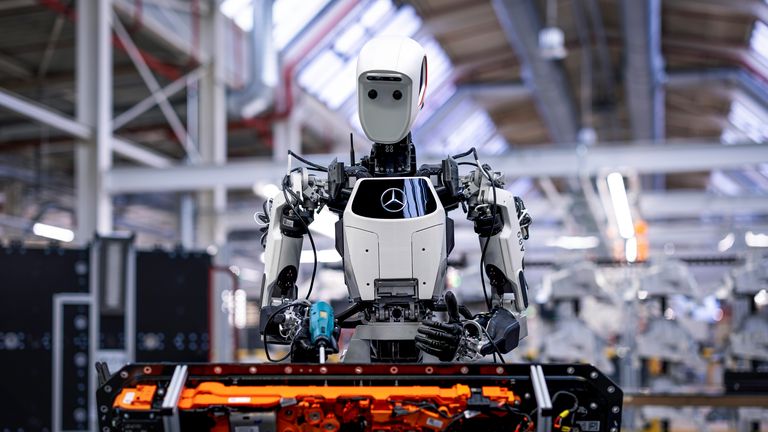Humanoid Robot Revolutionizes Real-World Tasks with Groundbreaking Development
A humanoid robot named Apollo has taken a significant, albeit tentative, step forward in the evolution of robotics. Standing at 5’8″, Apollo recently showcased its first public demonstration in a real-world environment by autonomously assembling an engine part.
With a simple twist of its servo-controlled wrists, Apollo clicked two components together and handed the completed part to a human colleague. While this may seem like a basic task, it represents an important milestone in the much-anticipated realm of humanoid robot advancement.
“This is a really big day for us,” stated Jeff Cardenas, CEO of Apptronik, the company behind Apollo. “We’re thrilled to display this technology and let the public see the robot live and in action.”
Mercedes-Benz has recently invested millions into Apptronik and is testing several humanoid robots at its factories in Berlin and Hungary. Both investors and industrial companies, especially automakers well-versed in robotic manufacturing, are closely monitoring the progress of human-like robots. The decline in costs for small, lightweight components, coupled with advances in AI algorithms and computer vision technology, has propelled progress in creating robots that can mimic human movement and perform tasks. However, despite numerous impressive cyborgs revealed by tech firms in the US and Asia, few have made their debut beyond laboratory settings.
In the expansive environment of the Berlin-Marienfelde plant, Apollo appears small and underpowered when surrounded by massive robotic arms that weld, bolt, and inspect Mercedes’ latest automobiles. Nonetheless, the integration of a humanoid robot is more than just a showcase, according to Mercedes-Benz. “The significant advantage is flexibility,” remarked Jorg Burzer, head of production and supply chain management at the car manufacturer. “A humanoid robot can be seamlessly introduced into an assembly line or logistics, and can easily shift between various tasks.”
Establishing a new assembly line or upgrading an existing one with traditional robotic arms requires substantial investment. A versatile robot that can adapt to multiple roles and collaborate with human workers could mitigate these costs. With hands and feet similar to ours, Apollo is capable of utilizing tools and operating within human spaces. It can lift over 25 kg and tackle repetitive tasks deemed too “dull, dirty, or dangerous” for humans.
The goal of the trials is to identify the tasks that humanoid robots can effectively perform while enhancing their machine learning and dexterity for more complex jobs. “We aim to discover what’s genuinely feasible,” stated Burzer. “Testing how a humanoid robot can work alongside our daily colleagues is also crucial.”
While the excitement surrounding humanoid robots continues to grow, Apptronik is cautious in its claims compared to some competitors. “People are eager for robots to come into their homes and handle chores,” expressed Cardenas, “but we are still very much in the early stages—comparable to the early ’80s of the personal computer revolution.”
Optimism about a future dominated by robots is palpable among investors. Some forecasts predict a twentyfold growth in the humanoid market over the next eight years, with expectations of millions of these machines by 2050. A significant challenge remains, however, as the AI required for a truly “general-purpose” robot capable of functioning in unpredictable environments is still under development. Currently, the concept of sophisticated “world models” for AI is a work in progress. Therefore, pressing concerns about humanoid robots taking over jobs or revolting against humans can be deferred for now.







